Welcome to the perfect Bolognese recipe. If you’re looking for a Bolognese that’s rich in flavor, easy to make, and deliciously authentic, you have come to the right place.
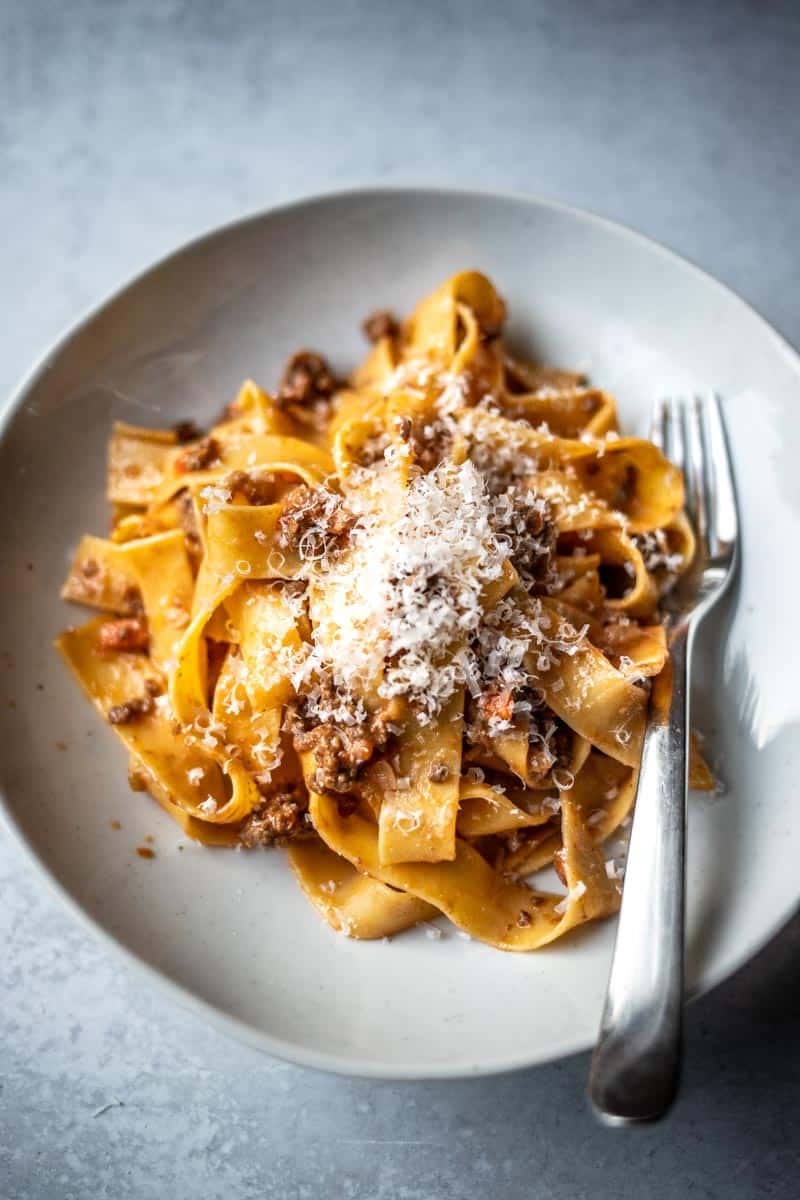
What Is Bolognese?
Bolognese is an Italian dish that originated in Bologna, Italy– hence the name. It’s a flavorful, thick sauce made with ground beef (and/or sometimes ground pork) and an Italian soffritto comprised of onions, carrots, and celery. It has a small amount of tomato sauce, but let us be clear– this is not a super tomatoey dish (more on that later). An authentic, really delicious bolognese has an incredibly bold, rich flavor when cooked properly. Bolognese is one of the most iconic Italian dishes and it’s always served with pasta.
Recipe Ingredients
- extra virgin olive oil
- onion
- celery
- carrot
- ground beef
- whole milk
- San Marzano tomatoes
- bay leaf
- parmesan rind
- kosher salt
- thick pasta such as pappardelle or tagliatelle
- Parmigiano Reggiano
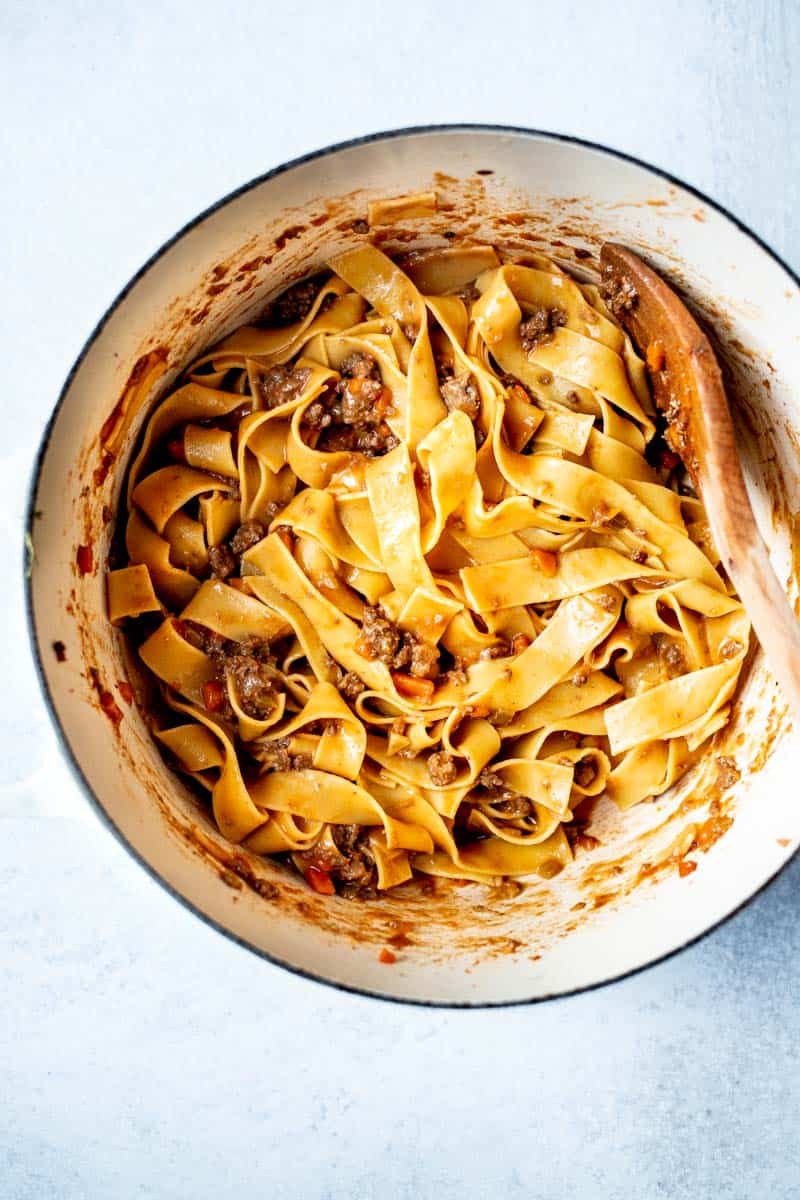
How To Pronounce Bolognese
If you haven’t heard the word Bolognese pronounced out loud before, you might be wondering how in the heck to say it. If we may: bow-low-nyay-zay. There you have it.
Bolognese Vs. Ragu: What’s the Difference?
Bolognese? Ragu? Are they the same thing or are they completely different? Both are delicious, but here are two main differences that distinguish them from each other:
- Ragu is a meat sauce and Bolognese is a variation of Ragu. While both sauces are made of ground meat and an Italian soffritto, Ragu traditionally has more tomato in it, so you will taste and associate tomatoes slightly more. Bolognese is less about the tomatoes. It’s a hearty, meaty sauce with a hint of tomato to bring the rich sauce some acidity, flavor, and color.
- Ragu is typically served with spaghetti, and bolognese is usually served with a wider pasta such as tagliatelle, pappardelle or lasagna
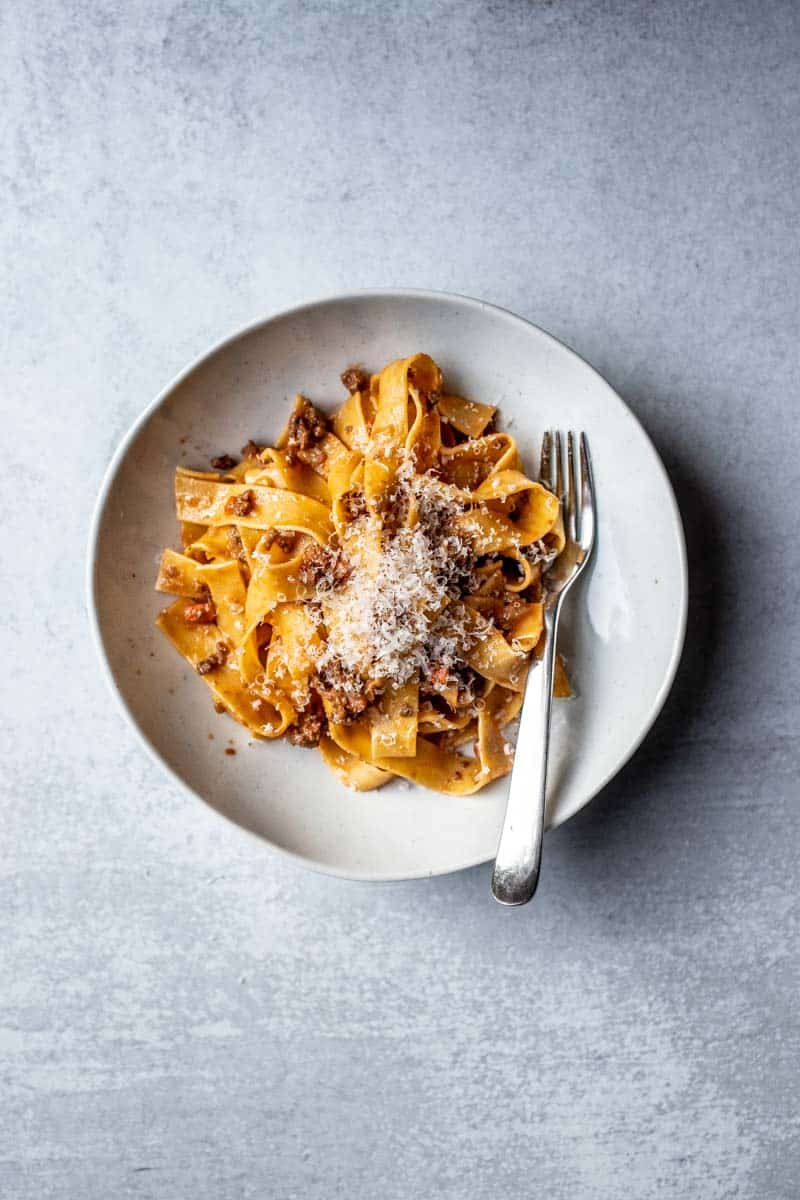
How To Make Bolognese Sauce
Making a swoon-worthy Bolognese sauce is not difficult. It does require time and some patience, but with a few simple ingredients and an afternoon on the stove, you’ll have a homemade Bolognese that will rival some of the best in Italy.
This Bolognese recipe is broken up into four basic steps:
- Prepare and cook the soffritto. A soffritto is simply diced vegetables cooked in oil. There are many soffrittos found in Mediterranean and Latin countries, but an Italian soffritto is traditionally made with onion, carrots, celery, and oil. After dicing your vegetables you’ll cook them at a low temperature with extra virgin olive oil until the vegetables are soft and have begun to caramelize. Make sure to not burn or overcook your soffritto– this is the foundation for the flavor of your Bolognese.
- Add the rest of the ingredients. Add the ground beef and cook until no longer pink. Add the cooking wine if using (see recipe for notes) and cook until evaporated. Add the whole milk and cook until evaporated. Then add the tomatoes, bay leaf, and parm rind if you have one. Give everything a good stir.
- Simmer, simmer, simmer. The secret to a killer Bolognese is allowing time to work its magic. You’ll want to simmer your Bolognese for a minimum of 2 hours, but up to 5 or 6 is ideal. Make sure to taste your Bolognese every so often so you can really observe the flavor develop and add salt if needed.
- Cook pasta and serve. After your Bolognese sauce has simmered and then simmered some more, cook one pound of pasta until perfectly al dente. Toss a reserved amount of the pasta water, 2 Tablespoons of butter, and pasta with the Bolognese, and portion onto plates. Top with copious amounts of Parmigiano-Reggiano and enjoy immediately.
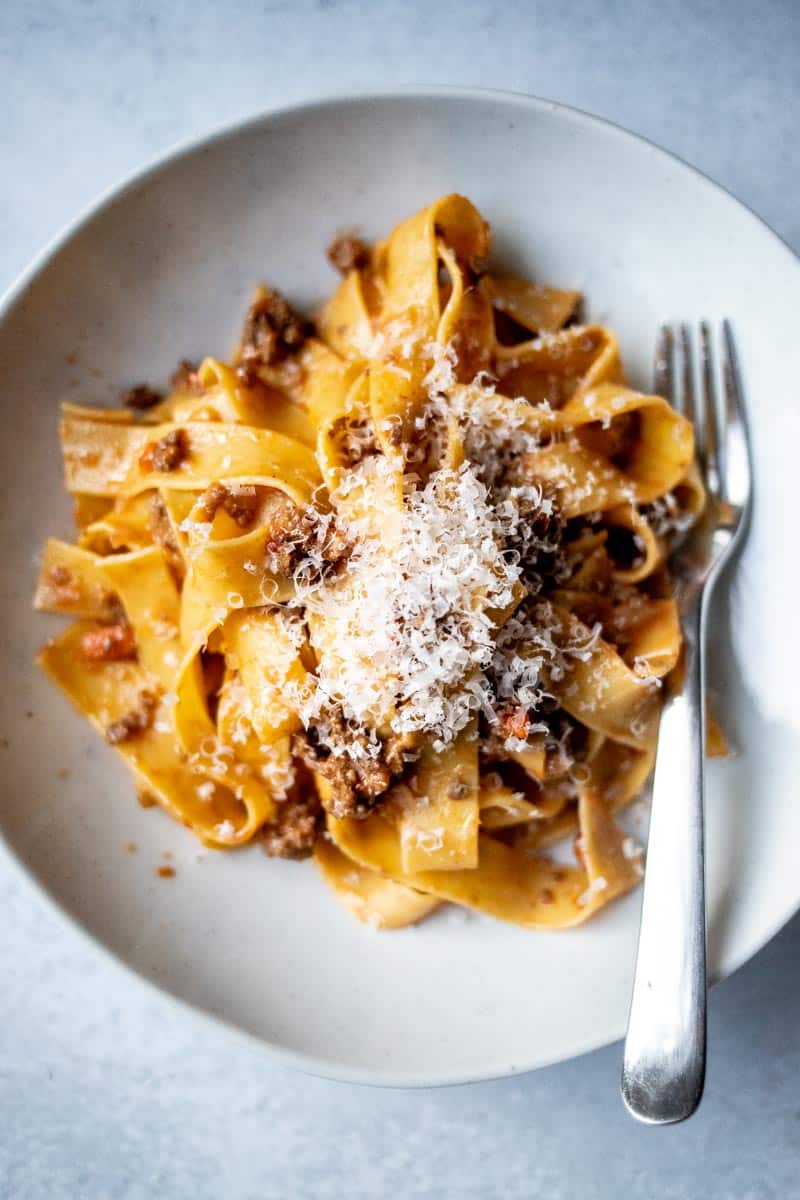
Freezing & Reheating Instructions
You can 100% freeze Bolognese and, in fact, it’s one of our preferred meals to freeze ahead and enjoy later. If you’re cooking this recipe just for two, prepare the entire recipe, serve half at the dinner table (with half of the amount of pasta), and freeze the other half of the Bolognese sauce for a rainy day. Or, you could easily double the Bolognese recipe for larger portions and freeze any extras as well. Just make sure that you prepare the pasta the same day that you serve it.
What Pasta is Best With This Recipe?
Bolognese is substantial so you want a pasta that can really support its weight and grandeur. In Italy, you’ll see it served primarily with tagliatelle or pappardelle– both ribbony, wide types of pasta that are ideal to support the substantialness of your homemade Bolognese. Bolognese is also often served in lasagne with accompanying layers of bechamel and Parmigiano-Reggiano. But by all means, please, if you only have a few random kinds of pasta in your pantry, this Bolognese recipe will taste delicious with just about anything.
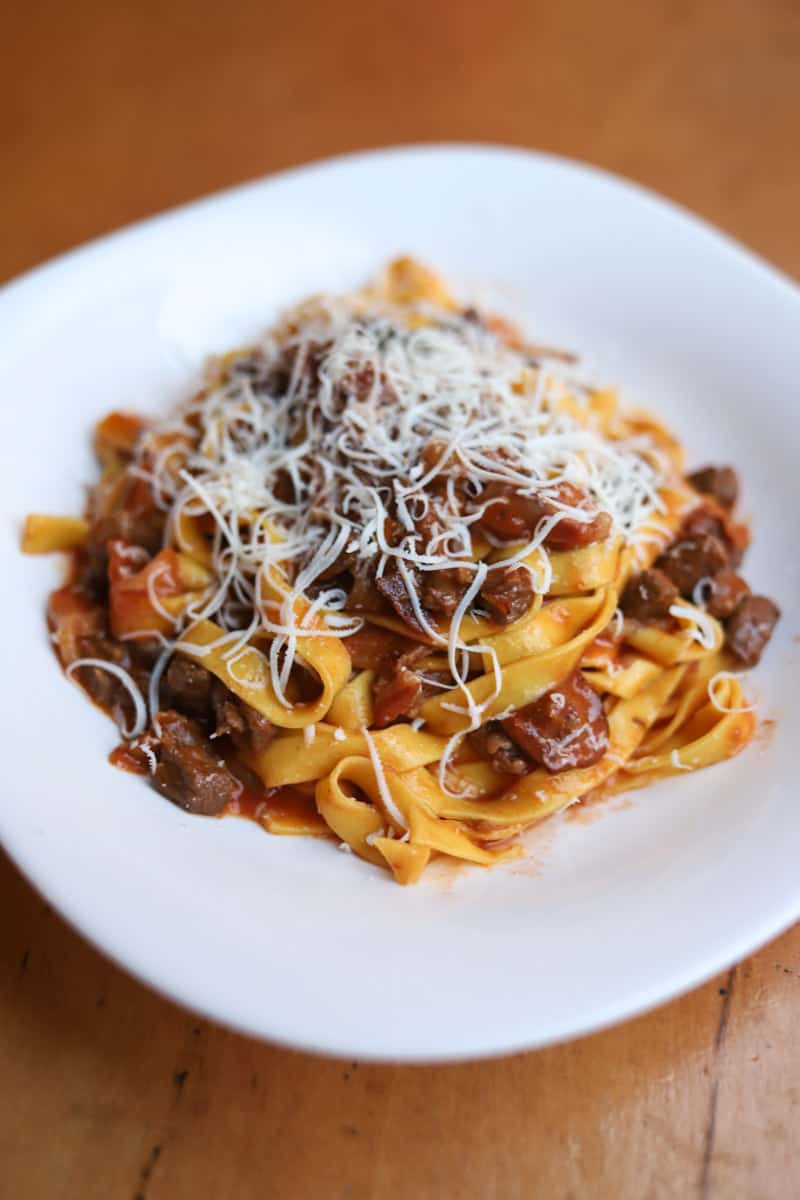
This recipe is inspired by several restaurants (featured on our dining guide to Bologna) including Sfoglia Rina, Le Golosita Di Nonna, and Vagh In Ufezzi.
Make Next: Perfect Homemade Pesto
The Perfect Bolognese Recipe
Ingredients
- 1/4 cup extra virgin olive oil
- 1/2 medium onion, diced
- 2 ribs celery, diced
- 1 large carrot, peeled and diced
- 1 lb. 80/20 ground beef
- 1 cup cooking wine (optional)*
- 1 cup whole milk
- 16 ounces whole, peeled San Marzano tomatoes**
- 1 bay leaf
- 1 parmesan rind (optional)***
- kosher salt
- 1 lb. thick pasta such as pappardelle or tagliatelle
- 2 Tablespoons unsalted butter
- Parmigiano-Reggiano for garnish
Instructions
- Heat a large dutch oven to medium heat. Add the olive oil and once warmed add the onion, celery, and carrots, and cook until soft and vegetables have begun to caramelize, about 10-20 minutes. Do not overcook or burn vegetables- if heat is too high adjust heat to medium-low or low.
- Crumble the ground beef over the vegetables, stir to combine, and cook until the meat is cooked completely and no longer pink. If using, add the cooking wine and cook until evaporated, about 5-10 minutes. Add the whole milk and cook until also evaporated, another 5-10 minutes.
- Using an immersion blender, traditional blender or food processor, pulse tomatoes for a few seconds, until they are mostly blended, but small scant pieces are still intact. Add the tomatoes, bay leaf, and parm rind to vegetables and meat and stir to incorporate. Salt to taste. Cook for a minimum of 2 hours and up to 5 hours, on the lowest possible simmer, uncovered, stirring every so often. Once complete, taste again and add additional salt if needed. Discard the parm rind and bay leaf.
- Once Bolognese is about 30 minutes from being done, prepare the pasta. Heavily salt a large pot of water and bring to a boil. Cook pasta until al dente, reserve 1 cup of pasta water, strain pasta and set aside. Using tongs, gently combine Bolognese, 1/2 cup pasta water, and 2 Tablespoons of butter with pasta. If pasta seems too dry add additional pasta water, a splash at a time. Top with copious amounts of grated Parmigiano-Reggiano and enjoy immediately.
Notes
Did you make this recipe?
Tag @femalefoodie so we can see what you’re cooking!


Kara
THIS WAS THE BEST PASTA IVE EVER MADE KR EATEN IN MY LIFE!! Thank you for sharing such amazing recipes!!!
Brooke Eliason
Thank you SO much Kara!